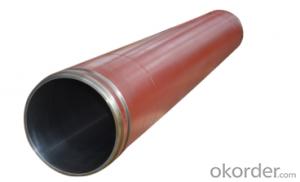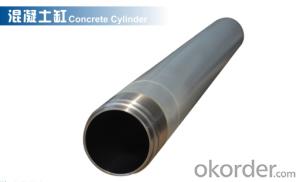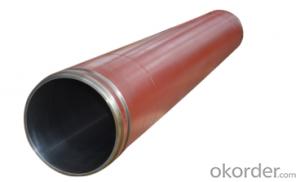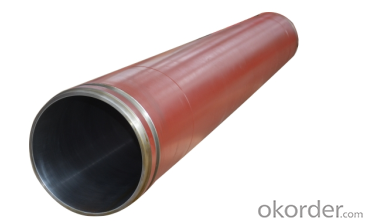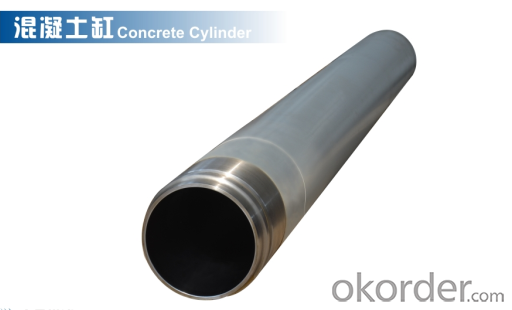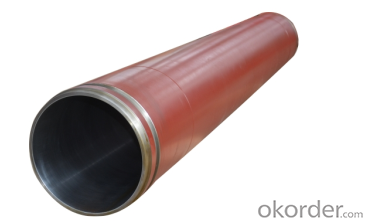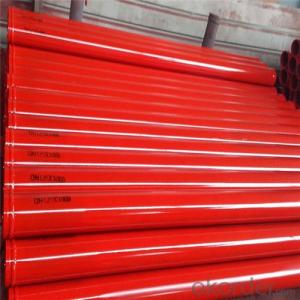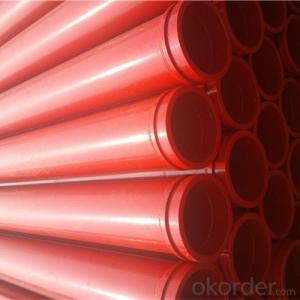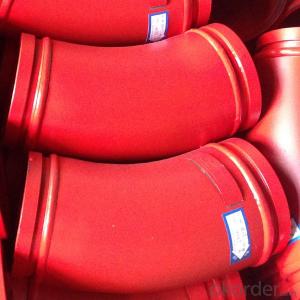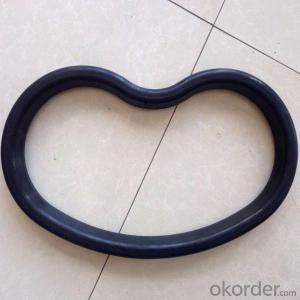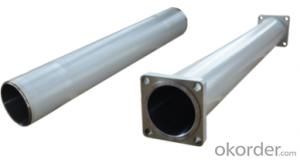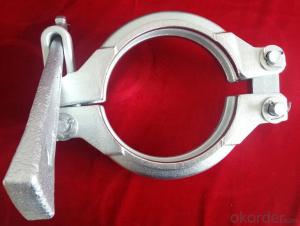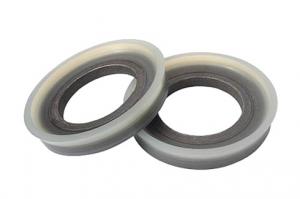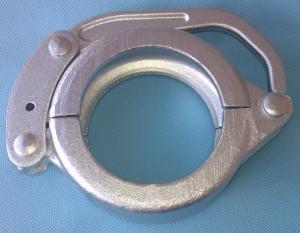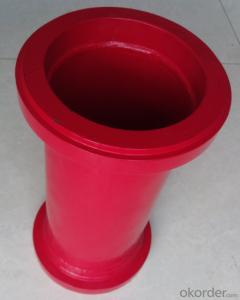DELIVERY CYLINDER(SCHWING ) I.D.:DN200 CR. THICKNESS :0.25MM-0.3MM COLOR:WHITE LENGTH:1775MM
- Loading Port:
- Shanghai
- Payment Terms:
- TT OR LC
- Min Order Qty:
- 2 pc
- Supply Capability:
- 1000 pc/month
OKorder Service Pledge
Quality Product, Order Online Tracking, Timely Delivery
OKorder Financial Service
Credit Rating, Credit Services, Credit Purchasing
You Might Also Like
Packaging & Delivery
| Packaging Detail: | wooden case, seaworthy packing |
| Delivery Detail: | 15 days |
Specifications
Concrete Pump Delivery Cylinder DN230*2100
1. Capacity: 60,000~80,000cbm
2. Size: DN180, DN200, DN230..
4. Brand: PM, Sany,ZM
Concrete Pump Delivery Cylinder DN230*2100
1. Material: C45
2. quenching and tempering to improve the hardness to HB241-280
3. inner wall chrome thickness is 0.25-0.30mm, hardness HV820-900.
4. Brand: SCHWING, PM, SANY, KYOKUTO, CIFA
5. Capacity: 60,000~80,000cbm
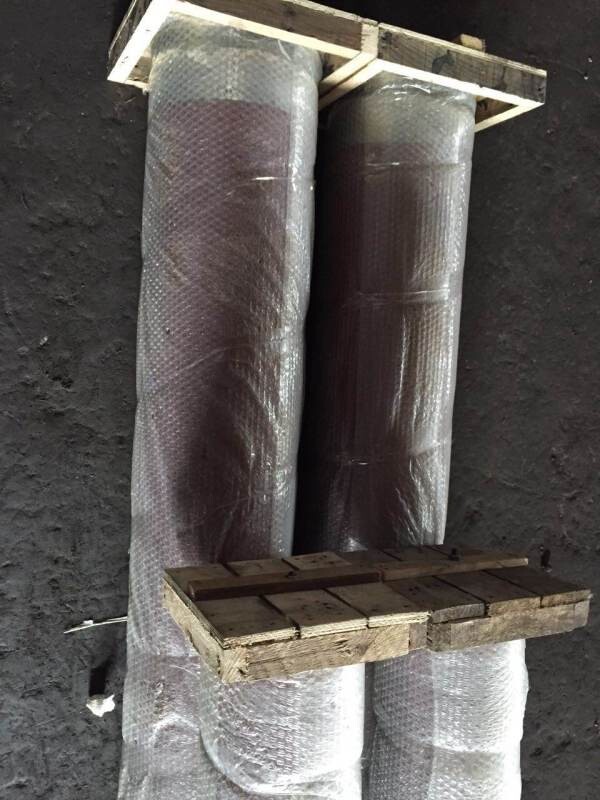
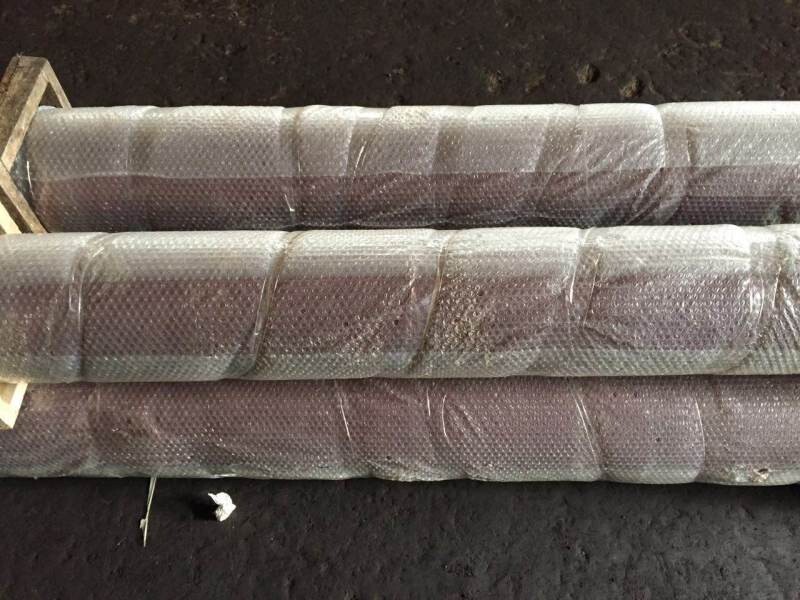

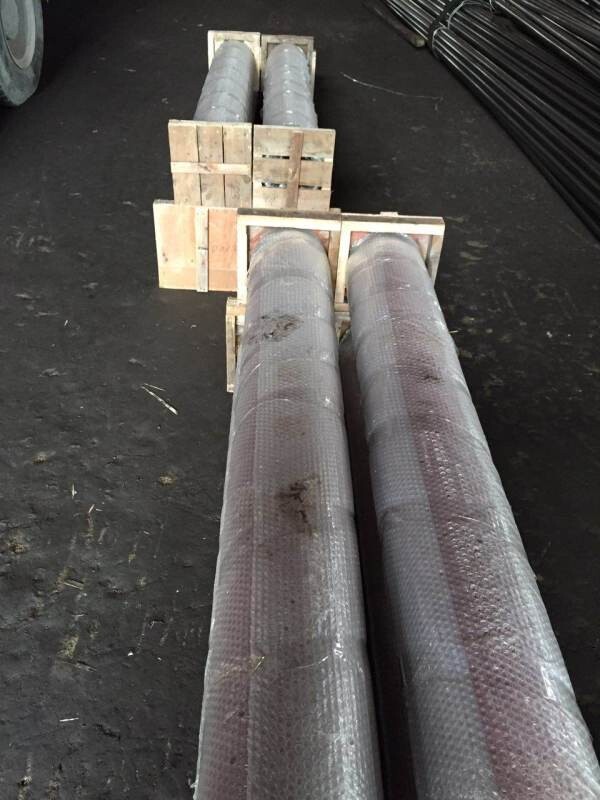

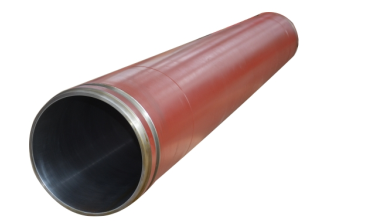
- Q: What is the function of a concrete pump hopper agitator shaft bearing?
- The function of a concrete pump hopper agitator shaft bearing is to provide support and facilitate smooth rotation of the agitator shaft, ensuring effective mixing of the concrete in the hopper.
- Q: What are the indicators of a faulty concrete pump seal?
- Some indicators of a faulty concrete pump seal include leakage of hydraulic fluid, loss of pressure during operation, unusual noises or vibrations, and difficulty in maintaining consistent flow of concrete.
- Q: What are the signs of a malfunctioning lubrication system?
- Some signs of a malfunctioning lubrication system include increased friction and heat, unusual noises coming from the engine or components, excessive wear and tear on moving parts, and a decrease in overall performance and efficiency of the machinery or vehicle.
- Q: How can a malfunctioning hydraulic motor affect the pumping process?
- Various negative effects can occur in the pumping process due to a hydraulic motor malfunction. Firstly, there may be a decrease in pumping efficiency. The hydraulic motor is responsible for converting hydraulic energy into mechanical energy, which drives the pumping mechanism. If the motor is not functioning properly, it may not generate enough power to operate the pumping system effectively, resulting in a decrease in the volume or pressure of the pumped fluid. Moreover, an increase in energy consumption can be caused by a faulty hydraulic motor. Inefficient or faulty motor operation can lead to higher energy requirements to maintain the desired pumping rate. This increased energy consumption can result in higher operating costs and reduced overall system performance. Furthermore, irregular pumping or complete pump failure can occur as a result of a malfunctioning hydraulic motor. If the motor is not operating correctly, it may cause intermittent or inconsistent pumping, leading to fluctuations in the flow rate or pressure of the pumped fluid. In extreme cases, the motor may stop working entirely, resulting in a total loss of pumping functionality. Additionally, the entire pumping system may experience increased wear and tear due to a malfunctioning hydraulic motor. Improper motor operation can create excessive vibration or heat, leading to premature failure of other components such as seals, bearings, or pistons. This can result in frequent maintenance or repair requirements, leading to increased downtime and costs. In summary, the pumping process can be significantly affected by a malfunctioning hydraulic motor. This includes decreased efficiency, increased energy consumption, irregular pumping or complete pump failure, and increased wear and tear on the system. It is essential to regularly inspect and maintain hydraulic motors to ensure proper functioning and avoid potential issues that may disrupt the pumping process.
- Q: How often should hopper agitator shafts be inspected or replaced in a concrete pump?
- To ensure optimal performance and prevent potential breakdowns, it is important to regularly inspect and maintain the hopper agitator shafts in a concrete pump. The frequency of inspection or replacement depends on factors such as pump usage and operating conditions. As a general rule, it is recommended to inspect the hopper agitator shafts every three to six months. During the inspection, check for signs of wear, damage, or misalignment. If any issues are found, take appropriate measures such as lubricating, realigning, or replacing damaged parts. However, it is crucial to consider the intensity of use, the materials being pumped, and the overall condition of the pump when determining the inspection frequency. For example, if the pump is used heavily or operates continuously, it may be necessary to inspect the agitator shafts on a monthly basis. Regular maintenance and inspection of hopper agitator shafts not only ensure smooth operation but also extend the equipment's lifespan. Detecting and resolving issues in a timely manner can prevent costly repairs or downtime in the future. Additionally, following the manufacturer's maintenance recommendations and guidelines can optimize performance and reliability.
- Q: How do I ensure the compatibility of mechanical components in concrete pump spare parts?
- To guarantee the compatibility of mechanical components in concrete pump spare parts, there are several essential measures you can take: 1. Determine the exact make and model of your concrete pump: Different concrete pumps may have different designs and specifications, so it is crucial to identify the specific make and model of your pump. This information will assist you in selecting the appropriate spare parts for your particular pump. 2. Review the manufacturer's documentation: Examine the manufacturer's documentation, which includes the user manual and parts catalog, to understand the recommended spare parts for your concrete pump. These documents typically provide detailed information on the compatibility of various mechanical components. 3. Seek guidance from the manufacturer or authorized dealers: If you have doubts about the compatibility of certain mechanical components, it is advisable to consult the manufacturer or authorized dealers. They possess extensive knowledge and experience with their products and can offer advice on choosing compatible spare parts. 4. Consider utilizing OEM (Original Equipment Manufacturer) parts: OEM parts are specifically designed and manufactured by the original equipment manufacturer. Employing OEM parts ensures the highest level of compatibility and reliability. Although they may be slightly more expensive than aftermarket alternatives, they often provide superior performance and longer service life. 5. Verify standardized sizing and specifications: Mechanical components, such as seals, gaskets, and bearings, frequently adhere to standardized sizes and specifications. Ensure that the spare parts you are considering match these standardized measurements to guarantee compatibility. 6. Conduct thorough research and comparison: Prior to purchasing spare parts, conduct research on various suppliers and compare their offerings. Look for reputable suppliers who specialize in concrete pump spare parts and have a proven track record of delivering high-quality, compatible components. 7. Perform compatibility testing: If you are unsure about the compatibility of a specific mechanical component, consider conducting compatibility tests. This may involve installing the spare part in your concrete pump and assessing its fit, function, and performance. If possible, seek assistance from a qualified mechanic or technician to assist you with these tests. By following these steps, you can ensure the compatibility of mechanical components in concrete pump spare parts, minimizing the risk of compatibility issues and ensuring the smooth operation and maintenance of your concrete pump.
- Q: What are the signs of a damaged concrete pump agitator motor?
- Indicators of a damaged concrete pump agitator motor include various signs: 1. Unusual noises: The presence of excessive grinding, rattling, or squeaking noises emanating from the agitator motor may suggest damage. These noises could possibly indicate the need for attention to worn-out bearings or other internal components. 2. Inconsistent operation: If irregular or inconsistent mixing of the concrete occurs, it could be a sign of a damaged agitator motor. Whether the concrete is not being mixed properly or the agitation speed is inconsistent, it is possible that the motor is damaged. 3. Overheating: To identify a problem, the agitator motor becoming excessively hot during operation may serve as a clue. Overheating can be the result of various issues, such as a faulty motor or insufficient lubrication. In such cases, it is crucial to promptly address the issue to prevent further damage and potential breakdown. 4. Vibrations: The occurrence of excessive vibrations during operation could indicate a damaged motor. Vibrations may arise from imbalanced or misaligned components within the motor, leading to reduced efficiency and increased wear and tear. 5. Electrical issues: If the motor experiences electrical problems, such as tripping circuit breakers or blowing fuses, it might suggest a damaged motor. These issues can result from faulty wiring, short circuits, or damaged electrical components, requiring the attention of a professional. 6. Reduced performance: A damaged agitator motor can cause reduced performance or decreased efficiency. If the agitator is not working as effectively as before, or if the concrete is not being mixed thoroughly, it could be a sign of motor damage. In case of suspicion regarding the damage of the concrete pump agitator motor, it is advisable to seek assistance from a professional technician or service provider with expertise in concrete pump machinery. They can accurately diagnose the issue and provide suitable solutions for repairing or replacing the damaged motor.
- Q: Are there any warranties or guarantees on concrete pump spare parts?
- Yes, there are warranties and guarantees available on concrete pump spare parts. Many reputable manufacturers and suppliers offer warranties to ensure the quality and performance of their products. These warranties typically cover defects in materials or workmanship and provide replacements or repairs within a specified time frame. It is important to check the terms and conditions of the warranty or guarantee provided by the specific supplier or manufacturer before purchasing concrete pump spare parts.
- Q: How can one determine the correct weight and balance requirements for concrete pump spare parts?
- To determine the correct weight and balance requirements for concrete pump spare parts, several factors need to be considered. Firstly, it is important to consult the manufacturer's specifications and guidelines for the specific concrete pump model. These documents often provide detailed information about the weight and balance requirements for each spare part. Secondly, understanding the function and purpose of each spare part is crucial. Different parts have varying weights and may have an impact on the overall balance of the pump. For instance, larger components such as booms or outriggers may require specific weight distribution to ensure stability during operation. Furthermore, considering the intended use and conditions of the concrete pump is essential. If the pump is expected to work in challenging terrains or extreme weather conditions, additional weight may be required to enhance stability. In addition to the manufacturer's guidelines, consulting with experts or engineers familiar with concrete pumps can provide valuable insights. They can help analyze the specific requirements of the pump and advise on the correct weight and balance requirements for the spare parts. Lastly, it is crucial to conduct thorough testing and inspections after installing any spare parts. This ensures that the weight and balance requirements are met, and any adjustments can be made if necessary. Overall, determining the correct weight and balance requirements for concrete pump spare parts involves a combination of understanding manufacturer guidelines, considering the purpose and conditions of the pump, seeking expert advice, and conducting proper testing and inspections.
- Q: How can one determine the correct hardness and durometer rating for rubber components in concrete pump spare parts?
- Several factors must be taken into consideration when determining the appropriate hardness and durometer rating for rubber components in concrete pump spare parts. To begin with, it is crucial to have a thorough understanding of the specific application requirements of the rubber components. This entails considering factors such as pressure, temperature, and frequency of use. Additionally, it is important to assess the compatibility of the rubber material with concrete and any other chemicals that may come into contact with the components. Ensuring chemical resistance is vital for guaranteeing the longevity and durability of the rubber parts. Furthermore, the anticipated load and stress on the rubber components must be carefully analyzed. This includes evaluating the weight of the concrete, the force exerted during pumping, and the potential for impact or abrasion. Moreover, environmental conditions should not be overlooked. Exposure to sunlight, extreme temperatures, or harsh weather conditions can significantly impact the performance and lifespan of rubber components. It is also essential to consider the specific type of rubber material being used. Different rubber compounds possess varying hardness and durometer ratings. Seeking guidance from rubber manufacturers or suppliers who specialize in concrete pump spare parts can provide valuable insights and recommendations based on their expertise and experience. Ultimately, determining the correct hardness and durometer rating for rubber components in concrete pump spare parts necessitates a meticulous evaluation of application requirements, compatibility, load and stress factors, environmental conditions, and expert advice.
Send your message to us
DELIVERY CYLINDER(SCHWING ) I.D.:DN200 CR. THICKNESS :0.25MM-0.3MM COLOR:WHITE LENGTH:1775MM
- Loading Port:
- Shanghai
- Payment Terms:
- TT OR LC
- Min Order Qty:
- 2 pc
- Supply Capability:
- 1000 pc/month
OKorder Service Pledge
Quality Product, Order Online Tracking, Timely Delivery
OKorder Financial Service
Credit Rating, Credit Services, Credit Purchasing
Similar products
Hot products
Hot Searches
Related keywords
